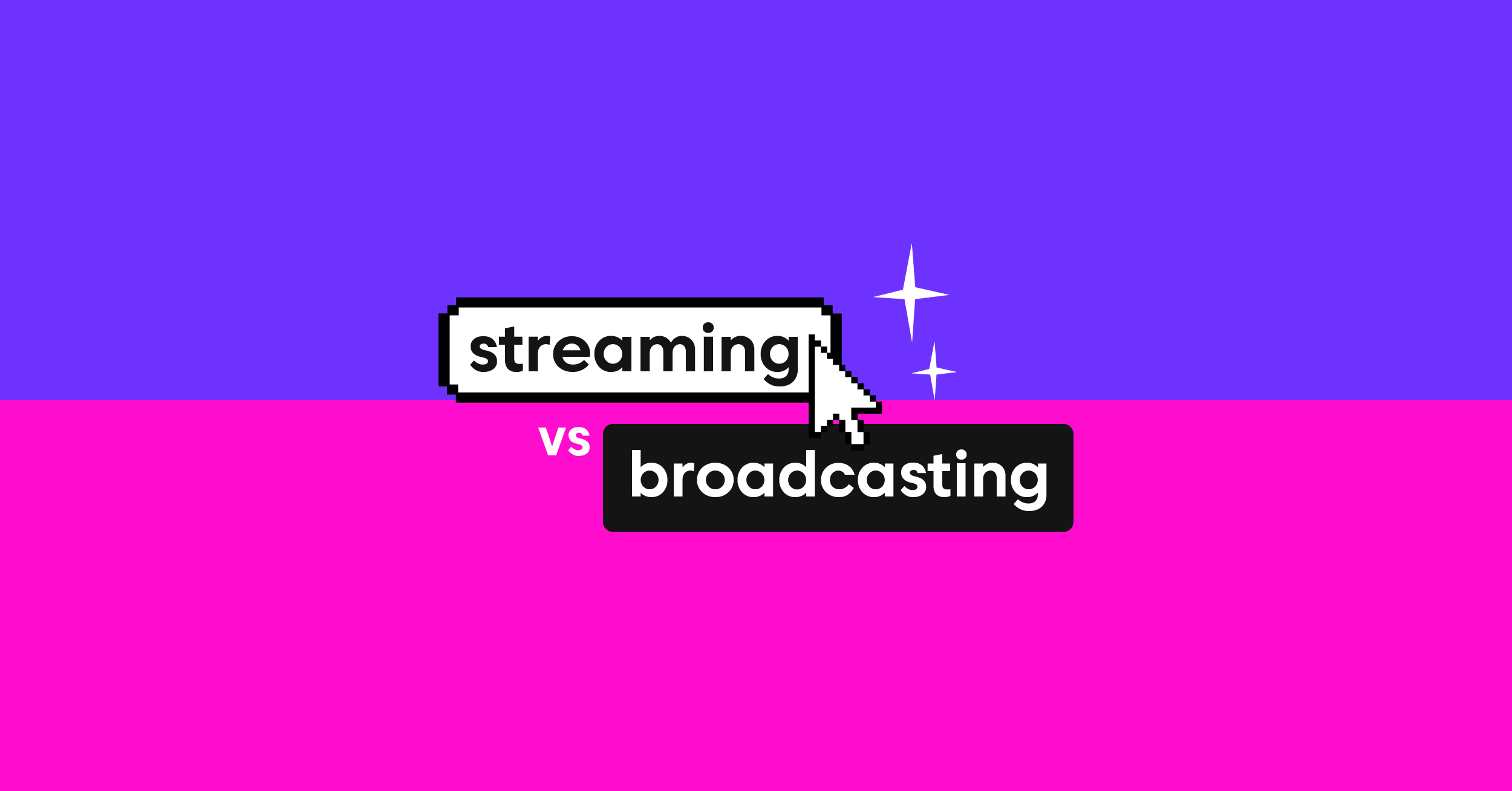Live video streaming is a growing trend all around the world. Since it’s an effective way for brands and businesses to communicate their ideas, message, or product directly to customers, live streaming is emerging as an excellent marketing strategy to reach out to the masses.
However, due to the nature of live video streaming, its success depends on several factors. If your stream is not high quality and fails for reliable content delivery, the whole point of broadcasting is defeated.
To succeed with live streaming, you need a reliable, low latency video streaming technology that delivers high video resolution without delay. Ultra-low latency streaming can ensure real-time communication with your audiences, and it’s possible with Castr– an innovative and highly effective live streaming technology.
The main objective of this post is to provide information about latency in streaming and how to stream with ultra-low latency using Castr. Let’s dive into the topic.
What is latency in streaming?
Live streaming is a two-way communication system and latency is a common term used in the live video streaming sector. In simple words, latency refers to the delay between a live event and its broadcasting.
Video latency can be either high or low depending on different factors like encoding type, bitrate of the video, streaming protocol, internet connection speed, and others.
Does latency affect streaming?
Latency is an important factor that can destroy the whole purpose of live streaming. If your audiences experience high video latency, they cannot enjoy real-time streaming and engagement with your message.
Since video streaming latency is a delay between the event and broadcasting, it can cause an interruption in communication resulting in low engagement rates, defeating the whole point of live streaming. High latency deprives the audience of real-time video streaming, which reduces the conversion rate.
What is low latency streaming?
Low latency streaming is the best way to ensure real-time communication between you and your audience. It delivers high video resolution without any delay, giving viewers a smooth experience of watching your live streaming events. Low latency refers to a few seconds of delay or less between the live event and broadcasting.
When you need your live stream to be viewed by a large number of people, you need a low latency streaming solution. Castr is the best video streaming solution that offers ultra-low latency live streaming facility.
Why is Low Latency Streaming Important?
An ultra-low latency streaming solution like Castr ensures real-time communication between you and your audience. It’s the best solution to ensure that every millisecond of your live streaming video is captured and delivered to your audience. It’s noteworthy that low latency video helps for real-time feedback from your audience. Moreover, live events with real-time latency, such as live presentations, video conferencing, concerts, church streaming, and sporting events, can benefit from low latency streaming.
What is good latency for streaming?
Low latency video streaming is the ability to stream video with minimal delay. There is no industry standard on an acceptable amount of latency. Still, users generally expect two seconds or less for live streaming and one second or less for pre-recorded content.
There are lots of video streaming software and services that offer to stream live video with their advanced features. But unfortunately, most of them have higher latency, which is the main obstacle to acquiring real-time engagement with your viewers. But an ultra low latency video streaming can ensure highly interactive live streams.
Castr uses advanced streaming technologies with ultra-low latency of x seconds that ensure high video quality and real-time engagement with the audience at the same time.
Low latency streaming protocols
The following are the protocols that are used to offer low latency streaming:
RTMP- Real-Time Messaging Protocol

RTMP stands for Real-time messaging protocol. It is a communication protocol used for streaming live video online. RTMP uses a client-server model with the server providing resources and services in exchange for client requests. Castr features an RTMP support that enables you to stream high-quality videos from both desktop and mobile devices at a very low latency of x seconds.
SRT Streaming Protocol
SRT or secure reliable transport is a low-latency open-source video transport protocol that uses the UDP transport protocol and is designed to transfer high-quality streaming content with minimal delay. This video streaming protocol was derived from the UDT project- designed for file transmission without delay.

Secure Reliable Transport has these excellent features:
- Controlled latency with source time transmission.
- Relaxed transmitter speed control
- Conditional packet drop “too late.”
- Anxious retransmission of packets.
WebRTC Protocol

WebRTC stands for Web Real-Time Communication. It’s a protocol that can be used with HTML5 and Javascript, allowing the capture of audio and video streaming directly from the browser, establishing real-time communications with other computers. WebRTC enables you to stream ultra-low latency video streaming.
HTTP Live Streaming Protocol

The Hypertext Transfer Protocol (HTTP) is a communication protocol based on TCP / IP.
The HTTP protocol allows information transfers; a data request is made between the client, and a server initiates the conversation. There is no control over the transmission since it does not save any data between two requests in the same session.
When TCP and HTTP experience a transmission error, the delivery of the lost packets is tried again until a confirmation is obtained that the information has arrived in its entirety. In direct video transmission, the HLS is used.
What category of Latency fits your use cases?
Since there are multiple latencies, it makes you confused about which one is the best for your streaming scenario.
Near Real-Time Latency: For video conferencing, video play, and video chat, this category is best. This Latency of video streaming depends on the end-to-end round trip time (RTT) of the network between source and destination. This RTT includes packet processing delay at each node along the path where data packets undergo network processing like filtering rules, etc., and transmission time over a particular link used to forward the packets.
The consequences of this Latency are:
- There can be no audio or video glitches, so if any packet is lost during transmission, you will notice the loss only at the next frame or when the video gets refreshed by replaying it from a fixed point in time.
- The delay between what the camera senses and what the viewer sees is very small.
Low Latency: Low Latency is required for gaming and production of live-streaming events like sports, news, etc. The Latency depends on the end-to-end delay between source and destination, including media encoding time at source node (broadcaster), network processing time in middle nodes (routers), and decoding time at the viewer’s device or player. For interactive content, low Latency is significant because it impacts the viewer’s experience.
Reduced Latency: For live premium content, reduced Latency is perfect.
HTTP Latencies: HTTP latencies are used for linear programming and one-way streams for large audiences.
Who needs low latency?
Latency is an obstacle in any streaming solution. When it’s higher, you experience hiccups, stutters, and interruptions during playback of the stream. Higher latency can overdare your streaming and impact on getting interactive streaming. Let’s check out a few live video streaming cases where low latency is important.
Streaming Video Games and E-Sports
Competitive gaming, or e-sports, is a rapidly growing industry that requires low latency to prevent lag from causing players to lose.
E-Sports live streaming has become popular in recent years. Services like Twitch allow the audience to watch competitive gamers play live and chat with other game fans. Viewers often tune in to see the best players in the world compete against each other. That’s why e-sports broadcasters need low-latency streaming technology to ensure a smooth viewing experience for their viewers.

Latency can be the difference between winning and losing a match. When playing a fast-paced action game, a few milliseconds delay can mean the difference between life and death. For example, in first shooters (FPS), players rely on their instincts and reflexes to survive. That’s why ultra-low-latency streaming technology is essential for certain games.
Real-Time Monitoring of Live Events
Another live streaming use case where low latency is important is real-time monitoring of events. Low-latency live streaming is ideal for any case where instant response time is required. This includes monitoring live concerts, sports games, and news events.
Live streaming of concerts is becoming increasingly popular. Fans want to watch their favorite artists perform live without having to leave the comfort of their homes. However, to get the best concert experience, fans need low latency streaming technology.
Second Screen Experiences
Another popular live streaming use case is second-screen experiences. People often watch TV while simultaneously using other devices like their laptops or mobile phones to get additional information about their show. Low-latency streaming enables this behavior by allowing viewers to interact with the stream without any delays between actions and responses on all devices involved in the experience.
Second-screen experiences are becoming more and more popular as people become accustomed to using multiple devices simultaneously. By providing a low-latency streaming solution, broadcasters can give their viewers the best possible TV watching experience.
Live Video Chat and Meetings

Low latency is also important for live video chat and meetings. In these cases, all participants in the discussion must see and hear each other without any delay. This requires a low-latency streaming solution that simultaneously handles large numbers of viewers.
Live video chat and meetings are becoming increasingly popular as people seek more efficient ways to communicate. Low latency streaming allows viewers to feel more connected and involved in the meeting or conversation, facilitating better communication between participants.
By providing low-latency video chat solutions, broadcasters can give their users an incredible way of connecting on a real-time basis while also giving advertisers new ways to connect with potential customers.
Remote Operations
In the enterprise world, low latency is vital for remote operations. In these cases, employees often need to collaborate on projects in real-time with colleagues and clients located across the globe. Low-latency live streaming can facilitate this kind of collaboration by allowing everyone involved in a project to interact seamlessly without any delays between actions and responses.
Conclusion
Low latency is an essential ingredient for a smooth live streaming experience. By using Castr’s ultra-low-latency streaming technology, broadcasters can ensure that their viewers have the best possible viewing experience. In addition, low latency provides several other benefits, such as real-time monitoring of events, second-screen experiences, live video chat and meetings, and remote operations. For these reasons, broadcasters need to consider implementing a low-latency streaming solution into their workflows.
Castr offers the ultra-low latency live streaming solution on the market. With Castr, you can ensure that your viewers will have a smooth and enjoyable viewing experience. Contact us today to learn more about how we can help you stream without delay.
Join 200,000+ streamers worldwide
With Castr, you can easily livestream videos on any platform in no time.
No Castr Branding
We do not include our branding on your videos.
No Commitment
No contracts. Cancel or change your plans anytime.
24/7 Support
Highly skilled in-house engineers ready to help.








